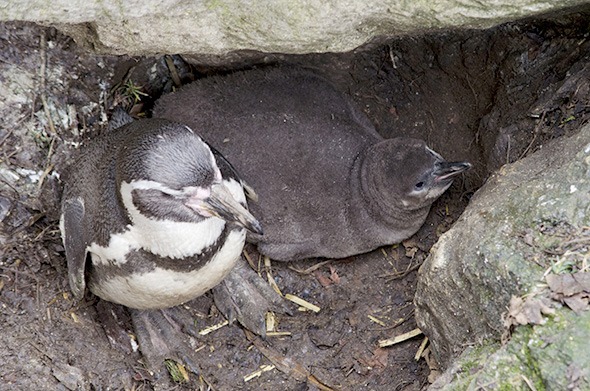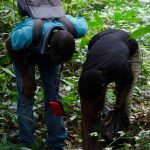Baby penguin doing well

Flamingo Land’s latest penguin chick is doing well and can be seen in the enclosure, cuddled up in a den under rocks with mum Lex or dad Alf looking after it.
The chick, which was born on 4th December 2014, still has its first coat of downy feathers and is very well camouflaged against the ground. It will be some weeks yet before it is old enough to swim or catch its own fish. Humboldt penguins usually fledge at about twelve weeks old.
Humboldt penguins are named after the Humboldt current in the Pacific Ocean, which flows north from Antarctica along the western coast of South America. When these penguins come ashore, it’s on to the rocky coasts of Chile and Peru, so very different from the typical image of penguins surrounded by ice and snow. Humboldt penguins are medium-sized and can be recognised by the black band that runs in a horseshoe shape across their white front. Their backs and tail are also black. Juvenile penguins can be recognised for their first year by the absence of the stripe on their front, so even once our baby one gets bigger, visitors can still spot it by looking for the penguin with a plain white front. Humboldt penguins get their distinctive stripe when they have their first adult moult at one year old.
Humboldt penguins are monogamous, usually pairing for life. They will typically lay two eggs in a burrow dug from sand or guano. Both adults share the task of incubating the eggs, which takes 40-42 days. The chicks are fed by their parents until they are old enough to fend for themselves; after that they will forage up and down the coast for a few months before establishing their own nests, often in the same colony as they were born in. Humboldt penguins have been known to live up to 30 years in captivity but would very rarely live for so long in the wild.
Humboldt penguins eat fish, krill and squid. They are particularly fond of anchovies, so over-fishing of species like this has led to food shortages for the penguins at times. They are also threatened by the removal of guano to make commercial fertiliser, which leaves the birds unable to construct burrows so that the eggs and chicks are more vulnerable to predators and bad weather. Other threats to Humboldt penguins include El Nino events, being caught as by-catch in fishing nets and pollution.


